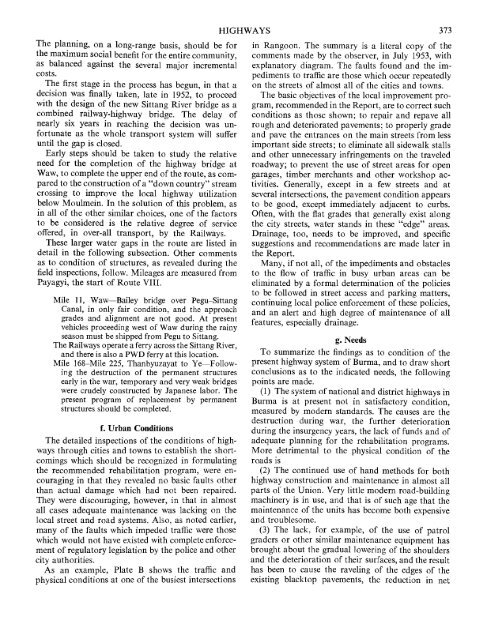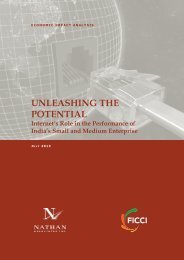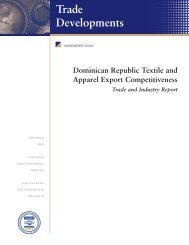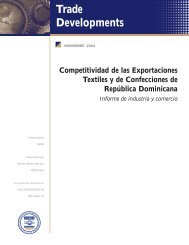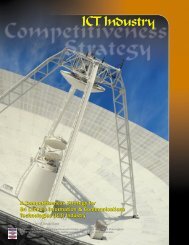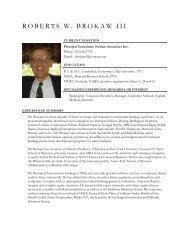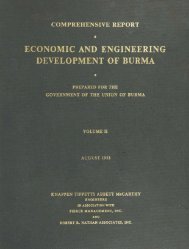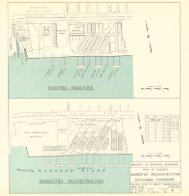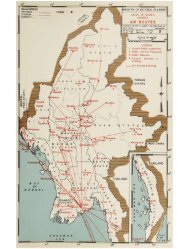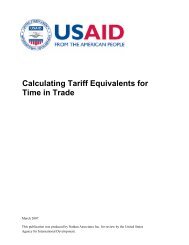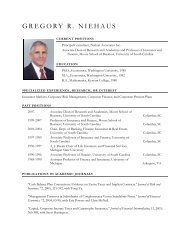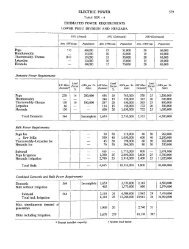Burma Development 1953 Vol1 Part11.pdf - Nathan Associates
Burma Development 1953 Vol1 Part11.pdf - Nathan Associates
Burma Development 1953 Vol1 Part11.pdf - Nathan Associates
- No tags were found...
You also want an ePaper? Increase the reach of your titles
YUMPU automatically turns print PDFs into web optimized ePapers that Google loves.
The planning, on a long-range basis, should be forthe maximum social benefit for the entire community,as balanced against the several major incrementalcosts.The first stage in the process has begun, in that adecision was finally taken, late in 1952, to proceedwith the design of the new Sktang River bridge as acombined railway-highway bridge. The delay ofnearly six years in reaching the decision was un¬fortunate as the whole transport system will sufferuntU the gap is closed.Early steps should be taken to study the relativeneed for the completion of the highway bridge atWaw, to complete the upper end of the route, as com¬pared to the construction of a "down country" streamcrossing to improve the local highway utilizationbelow Moulmein. In the solution of this problem, asin all of the other simUar choices, one of the factorsto be considered is the relative degree of serviceoffered, in over-aU transport, by the Railways.These larger water gaps in the route are listed indetail in the following subsection. Other commentsas to condition of structures, as revealed during thefield inspections, follow. Mileages are measured fromPayagyi, the start of Route VIII.Mile 11, Waw—Bailey bridge over Pegu-SittangCanal, in only fair condition, and the approachgrades and ahgnment are not good. At presentvehicles proceeding west of Waw during the rainyseason must be shipped from Pegu to Sittang.The Railways operate a ferry across the Sittang River,and there is also a PWD ferry at this location.MUe 168-Mile 225, Thanbyuzayat to Ye—Follow¬ing the destruction of the permanent structuresearly in the war, temporary and very weak bridgeswere crudely constructed by Japanese labor. Thepresent program of replacement by permanentstructures should be completed.f. Urban ConditionsThe detailed inspections of the conditions of high¬ways through cities and towns to establish the short¬comings which should be recognized in formulatingthe recommended rehabilitation program, were en¬couraging in that they revealed no basic faults otherthan actual damage which had not been repaired.They were discouraging, however, in that in almostall cases adequate maintenance was lacking on thelocal street and road systems. Also, as noted earlier,many of the faults which impeded traffic were thosewhich would not have existed with complete enforce¬ment of regulatory legislation by the police and othercity authorities.As an example, Plate B shows the traffic andphysical conditions at one of the busiest intersectionsHIGHWAYS 373in Rangoon. The summary is a literal copy of thecomments made by the observer, in July <strong>1953</strong>, withexplanatory diagram. The faults found and the im¬pediments to traffic are those which occur repeatedlyon the streets of almost all of the cities and towns.The basic objectives of the local improvement pro¬gram, recommended in the Report, are to correct suchconditions as those shown; to repair and repave allrough and deteriorated pavements; to properly gradeand pave the entrances on the main streets from lessimportant side streets; to ehminate all sidewalk stallsand other unnecessary infringements on the traveledroadway; to prevent the use of street areas for opengarages, timber merchants and other workshop ac¬tivities. Generally, except in a few streets and atseveral intersections, the pavement condition appearsto be good, except immediately adjacent to curbs.Often, with the flat grades that generaUy exist alongthe city streets, water stands in these "edge" areas.Drainage, too, needs to be improved, and specificsuggestions and recommendations are made later inthe Report.Many, if not all, of the impediments and obstaclesto the flow of traffic in busy urban areas can beeliminated by a formal determination of the policiesto be followed in street access and parking matters,continuing local police enforcement of these policies,and an alert and high degree of maintenance of allfeatures, especially drainage.g. NeedsTo summarize the findings as to condition of thepresent highway system of <strong>Burma</strong>, and to draw shortconclusions as to the indicated needs, the followingpoints are made.(1) The system of national and district highways in<strong>Burma</strong> is at present not in satisfactory condition,measured by modern standards. The causes are thedestruction during war, the further deteriorationduring the insurgency years, the lack of funds and ofadequate planning for the rehabihtation programs.More detrimental to the physical condition of theroads is(2) The continued use of hand methods for bothhighway construction and maintenance in almost aUparts of the Union. Very little modern road-buildingmachinery is in use, and that is of such age that themaintenance of the units has become both expensiveand troublesome.(3) The lack, for example, of the use of patrolgraders or other similar maintenance equipment hasbrought about the gradual lowering of the shouldersand the deterioration of their surfaces, and the resulthas been to cause the ravehng of the edges of theexisting blacktop pavements, the reduction in net


